Infection Control Practices in Dental Settings - PDF
VerifiedAdded on 2021/02/19
|17
|3470
|64
AI Summary
Contribute Materials
Your contribution can guide someone’s learning journey. Share your
documents today.
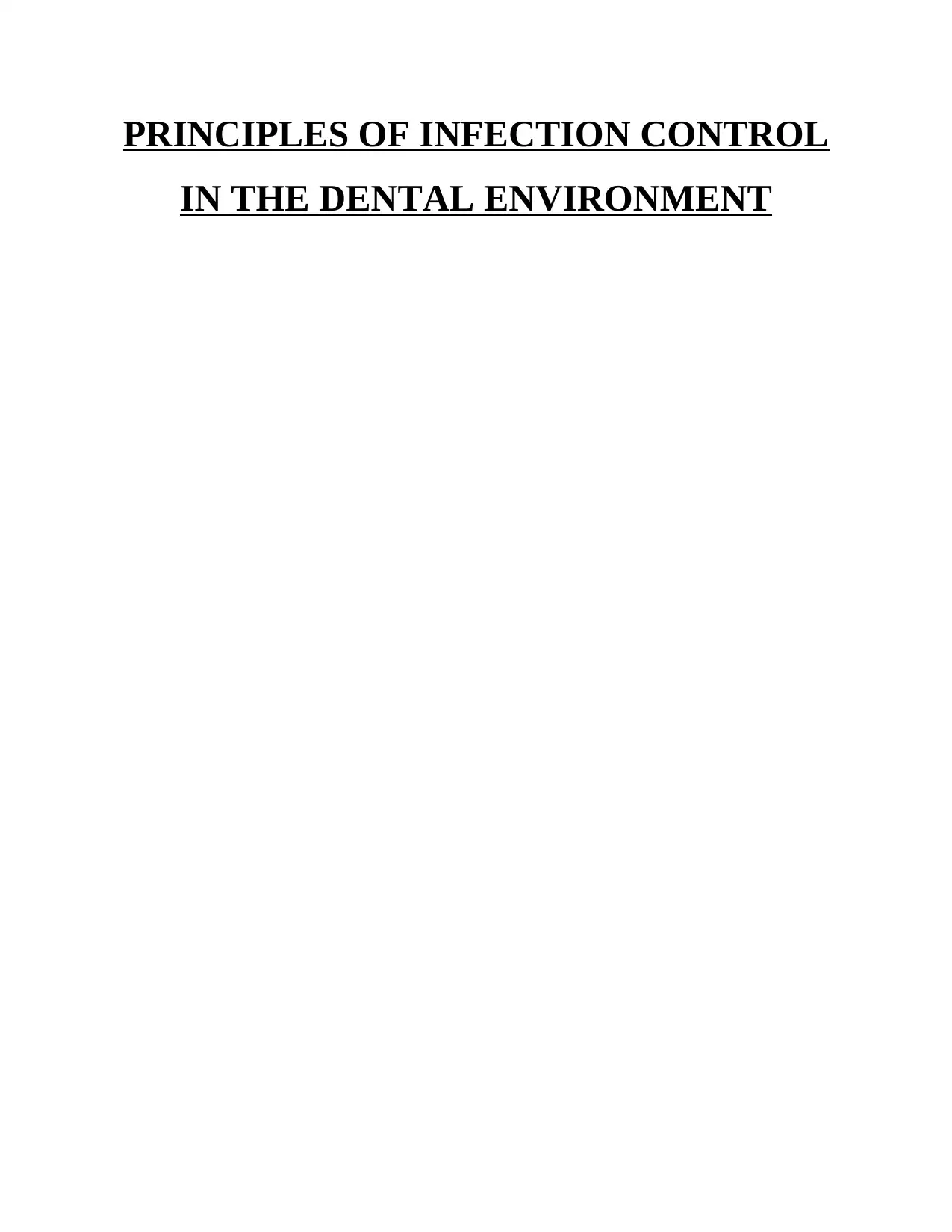
PRINCIPLES OF INFECTION CONTROL
IN THE DENTAL ENVIRONMENT
IN THE DENTAL ENVIRONMENT
Secure Best Marks with AI Grader
Need help grading? Try our AI Grader for instant feedback on your assignments.
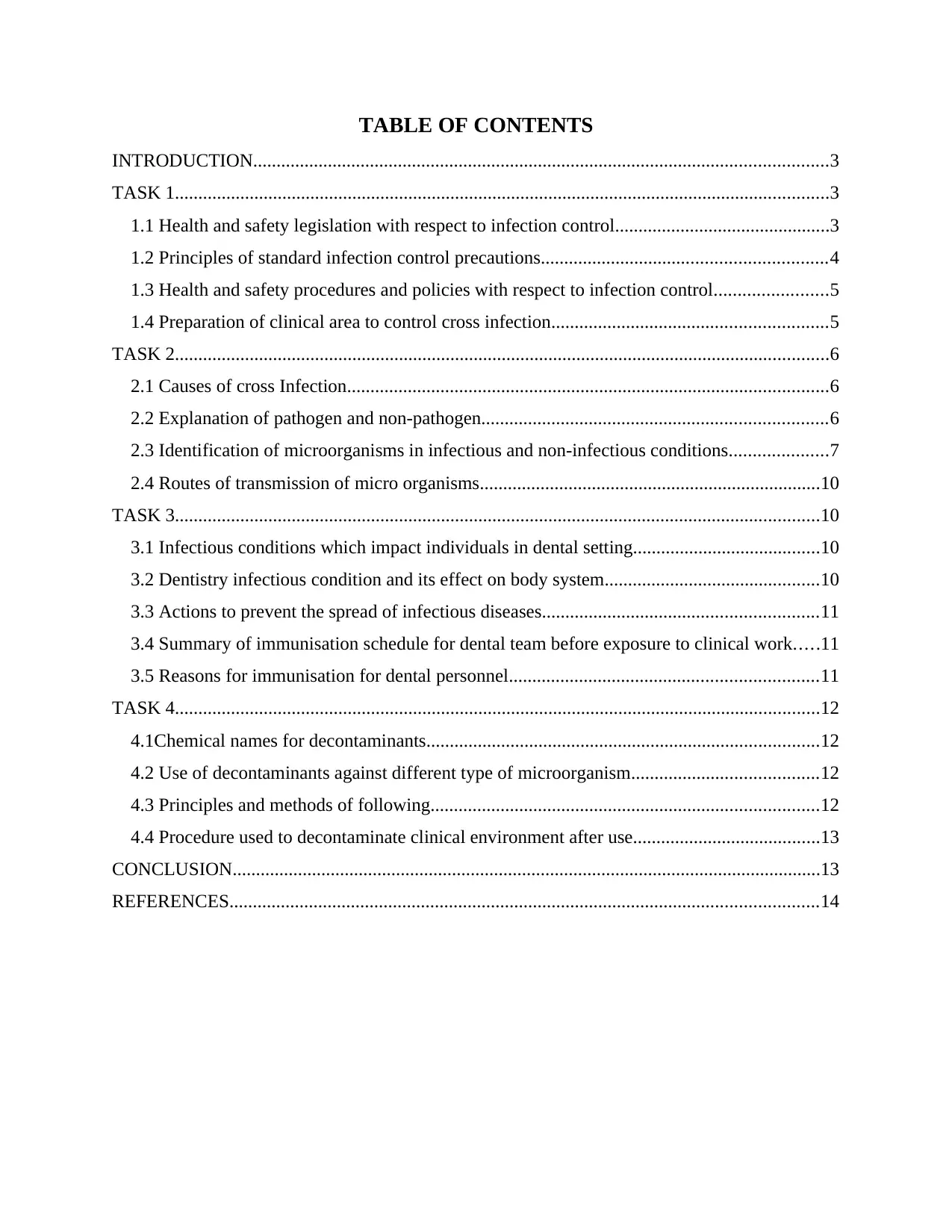
TABLE OF CONTENTS
INTRODUCTION...........................................................................................................................3
TASK 1............................................................................................................................................3
1.1 Health and safety legislation with respect to infection control..............................................3
1.2 Principles of standard infection control precautions.............................................................4
1.3 Health and safety procedures and policies with respect to infection control........................5
1.4 Preparation of clinical area to control cross infection...........................................................5
TASK 2............................................................................................................................................6
2.1 Causes of cross Infection.......................................................................................................6
2.2 Explanation of pathogen and non-pathogen..........................................................................6
2.3 Identification of microorganisms in infectious and non-infectious conditions.....................7
2.4 Routes of transmission of micro organisms.........................................................................10
TASK 3..........................................................................................................................................10
3.1 Infectious conditions which impact individuals in dental setting........................................10
3.2 Dentistry infectious condition and its effect on body system..............................................10
3.3 Actions to prevent the spread of infectious diseases...........................................................11
3.4 Summary of immunisation schedule for dental team before exposure to clinical work.....11
3.5 Reasons for immunisation for dental personnel..................................................................11
TASK 4..........................................................................................................................................12
4.1Chemical names for decontaminants....................................................................................12
4.2 Use of decontaminants against different type of microorganism........................................12
4.3 Principles and methods of following...................................................................................12
4.4 Procedure used to decontaminate clinical environment after use........................................13
CONCLUSION..............................................................................................................................13
REFERENCES..............................................................................................................................14
INTRODUCTION...........................................................................................................................3
TASK 1............................................................................................................................................3
1.1 Health and safety legislation with respect to infection control..............................................3
1.2 Principles of standard infection control precautions.............................................................4
1.3 Health and safety procedures and policies with respect to infection control........................5
1.4 Preparation of clinical area to control cross infection...........................................................5
TASK 2............................................................................................................................................6
2.1 Causes of cross Infection.......................................................................................................6
2.2 Explanation of pathogen and non-pathogen..........................................................................6
2.3 Identification of microorganisms in infectious and non-infectious conditions.....................7
2.4 Routes of transmission of micro organisms.........................................................................10
TASK 3..........................................................................................................................................10
3.1 Infectious conditions which impact individuals in dental setting........................................10
3.2 Dentistry infectious condition and its effect on body system..............................................10
3.3 Actions to prevent the spread of infectious diseases...........................................................11
3.4 Summary of immunisation schedule for dental team before exposure to clinical work.....11
3.5 Reasons for immunisation for dental personnel..................................................................11
TASK 4..........................................................................................................................................12
4.1Chemical names for decontaminants....................................................................................12
4.2 Use of decontaminants against different type of microorganism........................................12
4.3 Principles and methods of following...................................................................................12
4.4 Procedure used to decontaminate clinical environment after use........................................13
CONCLUSION..............................................................................................................................13
REFERENCES..............................................................................................................................14
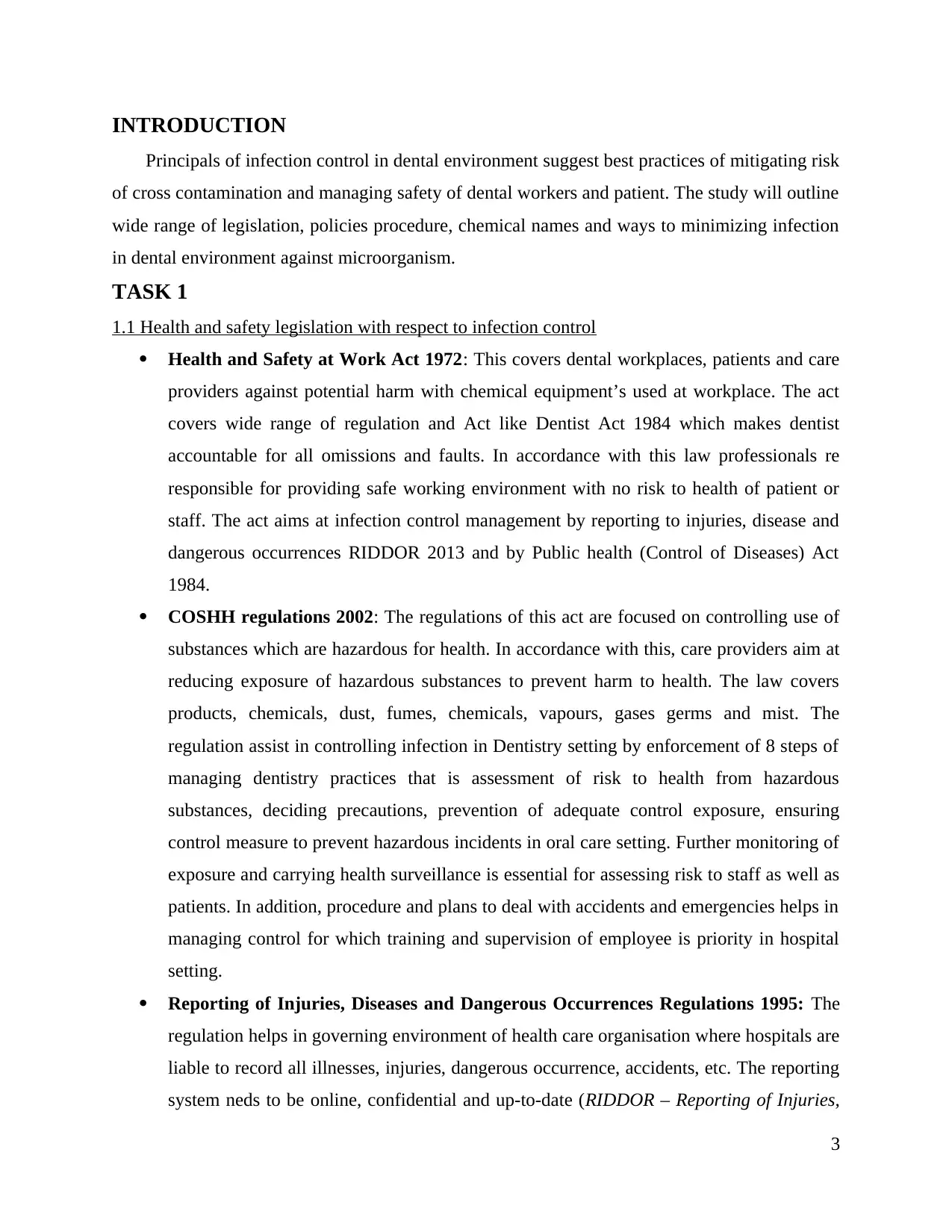
INTRODUCTION
Principals of infection control in dental environment suggest best practices of mitigating risk
of cross contamination and managing safety of dental workers and patient. The study will outline
wide range of legislation, policies procedure, chemical names and ways to minimizing infection
in dental environment against microorganism.
TASK 1
1.1 Health and safety legislation with respect to infection control
Health and Safety at Work Act 1972: This covers dental workplaces, patients and care
providers against potential harm with chemical equipment’s used at workplace. The act
covers wide range of regulation and Act like Dentist Act 1984 which makes dentist
accountable for all omissions and faults. In accordance with this law professionals re
responsible for providing safe working environment with no risk to health of patient or
staff. The act aims at infection control management by reporting to injuries, disease and
dangerous occurrences RIDDOR 2013 and by Public health (Control of Diseases) Act
1984.
COSHH regulations 2002: The regulations of this act are focused on controlling use of
substances which are hazardous for health. In accordance with this, care providers aim at
reducing exposure of hazardous substances to prevent harm to health. The law covers
products, chemicals, dust, fumes, chemicals, vapours, gases germs and mist. The
regulation assist in controlling infection in Dentistry setting by enforcement of 8 steps of
managing dentistry practices that is assessment of risk to health from hazardous
substances, deciding precautions, prevention of adequate control exposure, ensuring
control measure to prevent hazardous incidents in oral care setting. Further monitoring of
exposure and carrying health surveillance is essential for assessing risk to staff as well as
patients. In addition, procedure and plans to deal with accidents and emergencies helps in
managing control for which training and supervision of employee is priority in hospital
setting.
Reporting of Injuries, Diseases and Dangerous Occurrences Regulations 1995: The
regulation helps in governing environment of health care organisation where hospitals are
liable to record all illnesses, injuries, dangerous occurrence, accidents, etc. The reporting
system neds to be online, confidential and up-to-date (RIDDOR – Reporting of Injuries,
3
Principals of infection control in dental environment suggest best practices of mitigating risk
of cross contamination and managing safety of dental workers and patient. The study will outline
wide range of legislation, policies procedure, chemical names and ways to minimizing infection
in dental environment against microorganism.
TASK 1
1.1 Health and safety legislation with respect to infection control
Health and Safety at Work Act 1972: This covers dental workplaces, patients and care
providers against potential harm with chemical equipment’s used at workplace. The act
covers wide range of regulation and Act like Dentist Act 1984 which makes dentist
accountable for all omissions and faults. In accordance with this law professionals re
responsible for providing safe working environment with no risk to health of patient or
staff. The act aims at infection control management by reporting to injuries, disease and
dangerous occurrences RIDDOR 2013 and by Public health (Control of Diseases) Act
1984.
COSHH regulations 2002: The regulations of this act are focused on controlling use of
substances which are hazardous for health. In accordance with this, care providers aim at
reducing exposure of hazardous substances to prevent harm to health. The law covers
products, chemicals, dust, fumes, chemicals, vapours, gases germs and mist. The
regulation assist in controlling infection in Dentistry setting by enforcement of 8 steps of
managing dentistry practices that is assessment of risk to health from hazardous
substances, deciding precautions, prevention of adequate control exposure, ensuring
control measure to prevent hazardous incidents in oral care setting. Further monitoring of
exposure and carrying health surveillance is essential for assessing risk to staff as well as
patients. In addition, procedure and plans to deal with accidents and emergencies helps in
managing control for which training and supervision of employee is priority in hospital
setting.
Reporting of Injuries, Diseases and Dangerous Occurrences Regulations 1995: The
regulation helps in governing environment of health care organisation where hospitals are
liable to record all illnesses, injuries, dangerous occurrence, accidents, etc. The reporting
system neds to be online, confidential and up-to-date (RIDDOR – Reporting of Injuries,
3
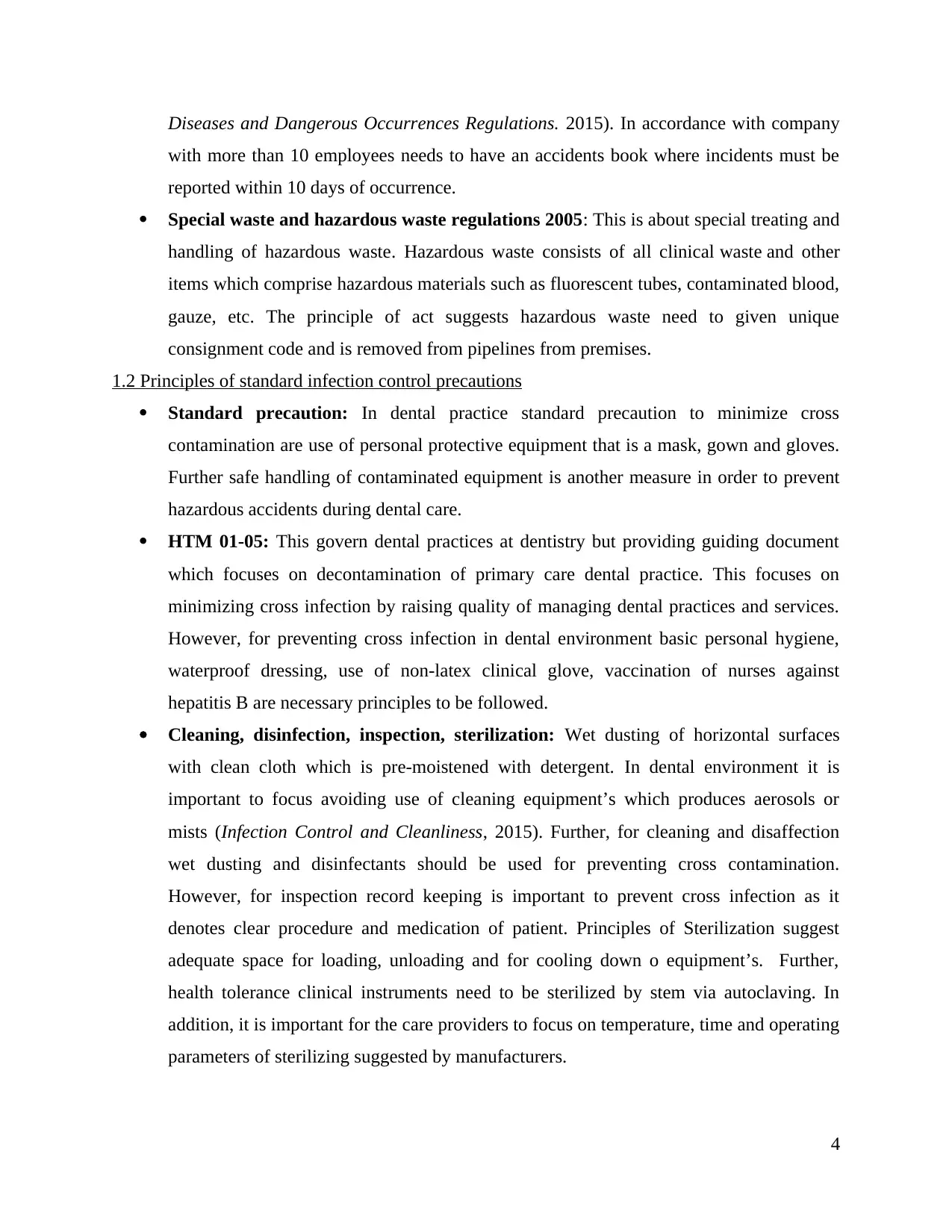
Diseases and Dangerous Occurrences Regulations. 2015). In accordance with company
with more than 10 employees needs to have an accidents book where incidents must be
reported within 10 days of occurrence.
Special waste and hazardous waste regulations 2005: This is about special treating and
handling of hazardous waste. Hazardous waste consists of all clinical waste and other
items which comprise hazardous materials such as fluorescent tubes, contaminated blood,
gauze, etc. The principle of act suggests hazardous waste need to given unique
consignment code and is removed from pipelines from premises.
1.2 Principles of standard infection control precautions
Standard precaution: In dental practice standard precaution to minimize cross
contamination are use of personal protective equipment that is a mask, gown and gloves.
Further safe handling of contaminated equipment is another measure in order to prevent
hazardous accidents during dental care.
HTM 01-05: This govern dental practices at dentistry but providing guiding document
which focuses on decontamination of primary care dental practice. This focuses on
minimizing cross infection by raising quality of managing dental practices and services.
However, for preventing cross infection in dental environment basic personal hygiene,
waterproof dressing, use of non-latex clinical glove, vaccination of nurses against
hepatitis B are necessary principles to be followed.
Cleaning, disinfection, inspection, sterilization: Wet dusting of horizontal surfaces
with clean cloth which is pre-moistened with detergent. In dental environment it is
important to focus avoiding use of cleaning equipment’s which produces aerosols or
mists (Infection Control and Cleanliness, 2015). Further, for cleaning and disaffection
wet dusting and disinfectants should be used for preventing cross contamination.
However, for inspection record keeping is important to prevent cross infection as it
denotes clear procedure and medication of patient. Principles of Sterilization suggest
adequate space for loading, unloading and for cooling down o equipment’s. Further,
health tolerance clinical instruments need to be sterilized by stem via autoclaving. In
addition, it is important for the care providers to focus on temperature, time and operating
parameters of sterilizing suggested by manufacturers.
4
with more than 10 employees needs to have an accidents book where incidents must be
reported within 10 days of occurrence.
Special waste and hazardous waste regulations 2005: This is about special treating and
handling of hazardous waste. Hazardous waste consists of all clinical waste and other
items which comprise hazardous materials such as fluorescent tubes, contaminated blood,
gauze, etc. The principle of act suggests hazardous waste need to given unique
consignment code and is removed from pipelines from premises.
1.2 Principles of standard infection control precautions
Standard precaution: In dental practice standard precaution to minimize cross
contamination are use of personal protective equipment that is a mask, gown and gloves.
Further safe handling of contaminated equipment is another measure in order to prevent
hazardous accidents during dental care.
HTM 01-05: This govern dental practices at dentistry but providing guiding document
which focuses on decontamination of primary care dental practice. This focuses on
minimizing cross infection by raising quality of managing dental practices and services.
However, for preventing cross infection in dental environment basic personal hygiene,
waterproof dressing, use of non-latex clinical glove, vaccination of nurses against
hepatitis B are necessary principles to be followed.
Cleaning, disinfection, inspection, sterilization: Wet dusting of horizontal surfaces
with clean cloth which is pre-moistened with detergent. In dental environment it is
important to focus avoiding use of cleaning equipment’s which produces aerosols or
mists (Infection Control and Cleanliness, 2015). Further, for cleaning and disaffection
wet dusting and disinfectants should be used for preventing cross contamination.
However, for inspection record keeping is important to prevent cross infection as it
denotes clear procedure and medication of patient. Principles of Sterilization suggest
adequate space for loading, unloading and for cooling down o equipment’s. Further,
health tolerance clinical instruments need to be sterilized by stem via autoclaving. In
addition, it is important for the care providers to focus on temperature, time and operating
parameters of sterilizing suggested by manufacturers.
4
Secure Best Marks with AI Grader
Need help grading? Try our AI Grader for instant feedback on your assignments.
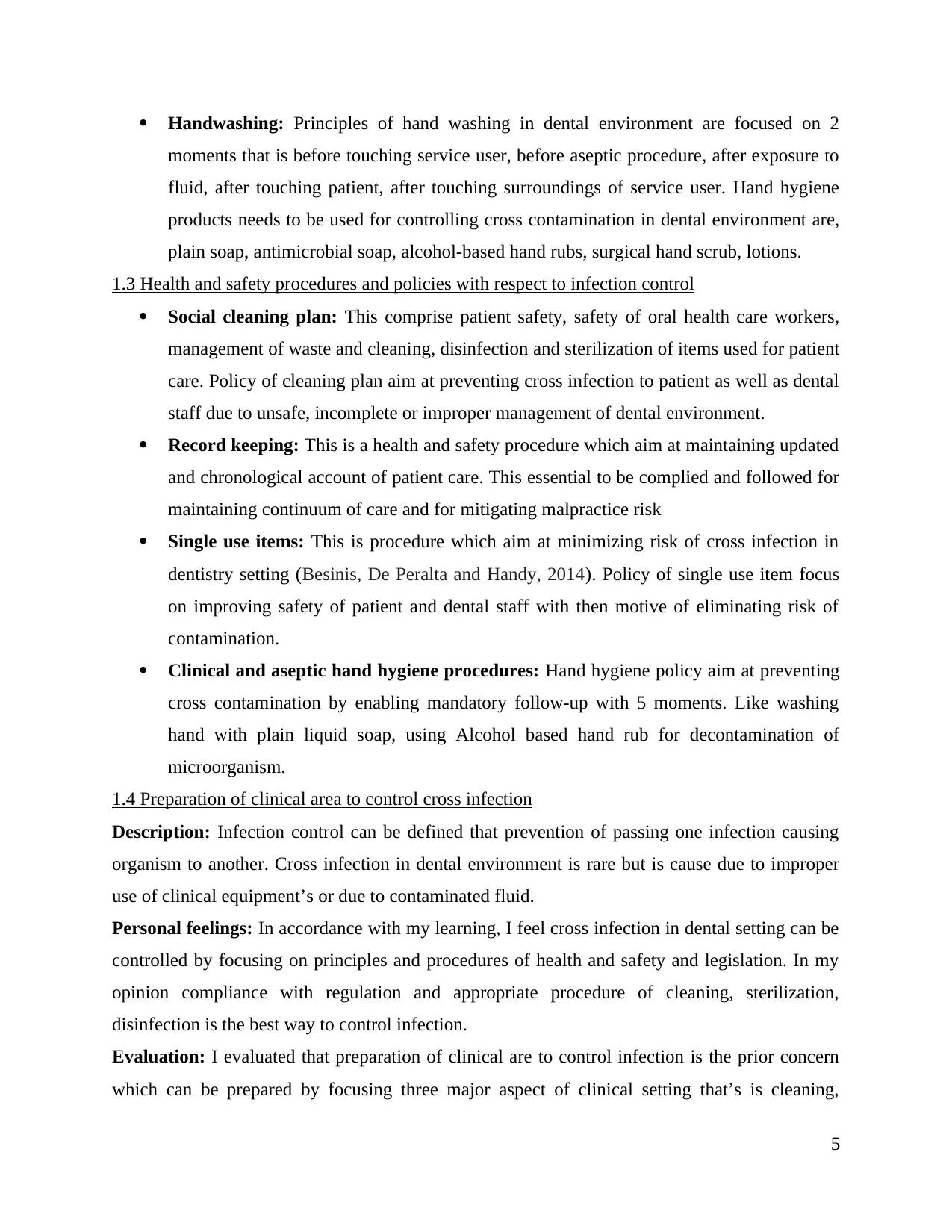
Handwashing: Principles of hand washing in dental environment are focused on 2
moments that is before touching service user, before aseptic procedure, after exposure to
fluid, after touching patient, after touching surroundings of service user. Hand hygiene
products needs to be used for controlling cross contamination in dental environment are,
plain soap, antimicrobial soap, alcohol-based hand rubs, surgical hand scrub, lotions.
1.3 Health and safety procedures and policies with respect to infection control
Social cleaning plan: This comprise patient safety, safety of oral health care workers,
management of waste and cleaning, disinfection and sterilization of items used for patient
care. Policy of cleaning plan aim at preventing cross infection to patient as well as dental
staff due to unsafe, incomplete or improper management of dental environment.
Record keeping: This is a health and safety procedure which aim at maintaining updated
and chronological account of patient care. This essential to be complied and followed for
maintaining continuum of care and for mitigating malpractice risk
Single use items: This is procedure which aim at minimizing risk of cross infection in
dentistry setting (Besinis, De Peralta and Handy, 2014). Policy of single use item focus
on improving safety of patient and dental staff with then motive of eliminating risk of
contamination.
Clinical and aseptic hand hygiene procedures: Hand hygiene policy aim at preventing
cross contamination by enabling mandatory follow-up with 5 moments. Like washing
hand with plain liquid soap, using Alcohol based hand rub for decontamination of
microorganism.
1.4 Preparation of clinical area to control cross infection
Description: Infection control can be defined that prevention of passing one infection causing
organism to another. Cross infection in dental environment is rare but is cause due to improper
use of clinical equipment’s or due to contaminated fluid.
Personal feelings: In accordance with my learning, I feel cross infection in dental setting can be
controlled by focusing on principles and procedures of health and safety and legislation. In my
opinion compliance with regulation and appropriate procedure of cleaning, sterilization,
disinfection is the best way to control infection.
Evaluation: I evaluated that preparation of clinical are to control infection is the prior concern
which can be prepared by focusing three major aspect of clinical setting that’s is cleaning,
5
moments that is before touching service user, before aseptic procedure, after exposure to
fluid, after touching patient, after touching surroundings of service user. Hand hygiene
products needs to be used for controlling cross contamination in dental environment are,
plain soap, antimicrobial soap, alcohol-based hand rubs, surgical hand scrub, lotions.
1.3 Health and safety procedures and policies with respect to infection control
Social cleaning plan: This comprise patient safety, safety of oral health care workers,
management of waste and cleaning, disinfection and sterilization of items used for patient
care. Policy of cleaning plan aim at preventing cross infection to patient as well as dental
staff due to unsafe, incomplete or improper management of dental environment.
Record keeping: This is a health and safety procedure which aim at maintaining updated
and chronological account of patient care. This essential to be complied and followed for
maintaining continuum of care and for mitigating malpractice risk
Single use items: This is procedure which aim at minimizing risk of cross infection in
dentistry setting (Besinis, De Peralta and Handy, 2014). Policy of single use item focus
on improving safety of patient and dental staff with then motive of eliminating risk of
contamination.
Clinical and aseptic hand hygiene procedures: Hand hygiene policy aim at preventing
cross contamination by enabling mandatory follow-up with 5 moments. Like washing
hand with plain liquid soap, using Alcohol based hand rub for decontamination of
microorganism.
1.4 Preparation of clinical area to control cross infection
Description: Infection control can be defined that prevention of passing one infection causing
organism to another. Cross infection in dental environment is rare but is cause due to improper
use of clinical equipment’s or due to contaminated fluid.
Personal feelings: In accordance with my learning, I feel cross infection in dental setting can be
controlled by focusing on principles and procedures of health and safety and legislation. In my
opinion compliance with regulation and appropriate procedure of cleaning, sterilization,
disinfection is the best way to control infection.
Evaluation: I evaluated that preparation of clinical are to control infection is the prior concern
which can be prepared by focusing three major aspect of clinical setting that’s is cleaning,
5
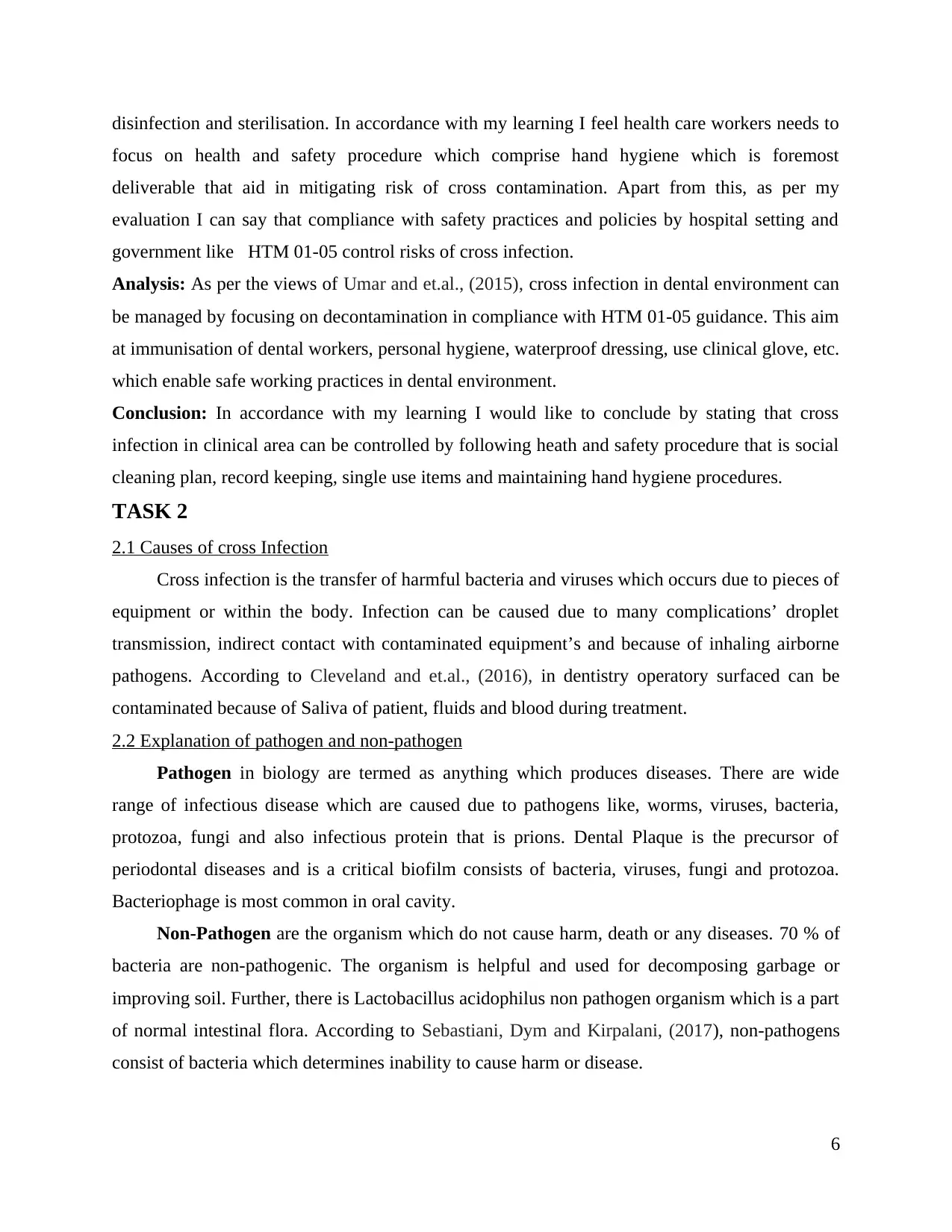
disinfection and sterilisation. In accordance with my learning I feel health care workers needs to
focus on health and safety procedure which comprise hand hygiene which is foremost
deliverable that aid in mitigating risk of cross contamination. Apart from this, as per my
evaluation I can say that compliance with safety practices and policies by hospital setting and
government like HTM 01-05 control risks of cross infection.
Analysis: As per the views of Umar and et.al., (2015), cross infection in dental environment can
be managed by focusing on decontamination in compliance with HTM 01-05 guidance. This aim
at immunisation of dental workers, personal hygiene, waterproof dressing, use clinical glove, etc.
which enable safe working practices in dental environment.
Conclusion: In accordance with my learning I would like to conclude by stating that cross
infection in clinical area can be controlled by following heath and safety procedure that is social
cleaning plan, record keeping, single use items and maintaining hand hygiene procedures.
TASK 2
2.1 Causes of cross Infection
Cross infection is the transfer of harmful bacteria and viruses which occurs due to pieces of
equipment or within the body. Infection can be caused due to many complications’ droplet
transmission, indirect contact with contaminated equipment’s and because of inhaling airborne
pathogens. According to Cleveland and et.al., (2016), in dentistry operatory surfaced can be
contaminated because of Saliva of patient, fluids and blood during treatment.
2.2 Explanation of pathogen and non-pathogen
Pathogen in biology are termed as anything which produces diseases. There are wide
range of infectious disease which are caused due to pathogens like, worms, viruses, bacteria,
protozoa, fungi and also infectious protein that is prions. Dental Plaque is the precursor of
periodontal diseases and is a critical biofilm consists of bacteria, viruses, fungi and protozoa.
Bacteriophage is most common in oral cavity.
Non-Pathogen are the organism which do not cause harm, death or any diseases. 70 % of
bacteria are non-pathogenic. The organism is helpful and used for decomposing garbage or
improving soil. Further, there is Lactobacillus acidophilus non pathogen organism which is a part
of normal intestinal flora. According to Sebastiani, Dym and Kirpalani, (2017), non-pathogens
consist of bacteria which determines inability to cause harm or disease.
6
focus on health and safety procedure which comprise hand hygiene which is foremost
deliverable that aid in mitigating risk of cross contamination. Apart from this, as per my
evaluation I can say that compliance with safety practices and policies by hospital setting and
government like HTM 01-05 control risks of cross infection.
Analysis: As per the views of Umar and et.al., (2015), cross infection in dental environment can
be managed by focusing on decontamination in compliance with HTM 01-05 guidance. This aim
at immunisation of dental workers, personal hygiene, waterproof dressing, use clinical glove, etc.
which enable safe working practices in dental environment.
Conclusion: In accordance with my learning I would like to conclude by stating that cross
infection in clinical area can be controlled by following heath and safety procedure that is social
cleaning plan, record keeping, single use items and maintaining hand hygiene procedures.
TASK 2
2.1 Causes of cross Infection
Cross infection is the transfer of harmful bacteria and viruses which occurs due to pieces of
equipment or within the body. Infection can be caused due to many complications’ droplet
transmission, indirect contact with contaminated equipment’s and because of inhaling airborne
pathogens. According to Cleveland and et.al., (2016), in dentistry operatory surfaced can be
contaminated because of Saliva of patient, fluids and blood during treatment.
2.2 Explanation of pathogen and non-pathogen
Pathogen in biology are termed as anything which produces diseases. There are wide
range of infectious disease which are caused due to pathogens like, worms, viruses, bacteria,
protozoa, fungi and also infectious protein that is prions. Dental Plaque is the precursor of
periodontal diseases and is a critical biofilm consists of bacteria, viruses, fungi and protozoa.
Bacteriophage is most common in oral cavity.
Non-Pathogen are the organism which do not cause harm, death or any diseases. 70 % of
bacteria are non-pathogenic. The organism is helpful and used for decomposing garbage or
improving soil. Further, there is Lactobacillus acidophilus non pathogen organism which is a part
of normal intestinal flora. According to Sebastiani, Dym and Kirpalani, (2017), non-pathogens
consist of bacteria which determines inability to cause harm or disease.
6
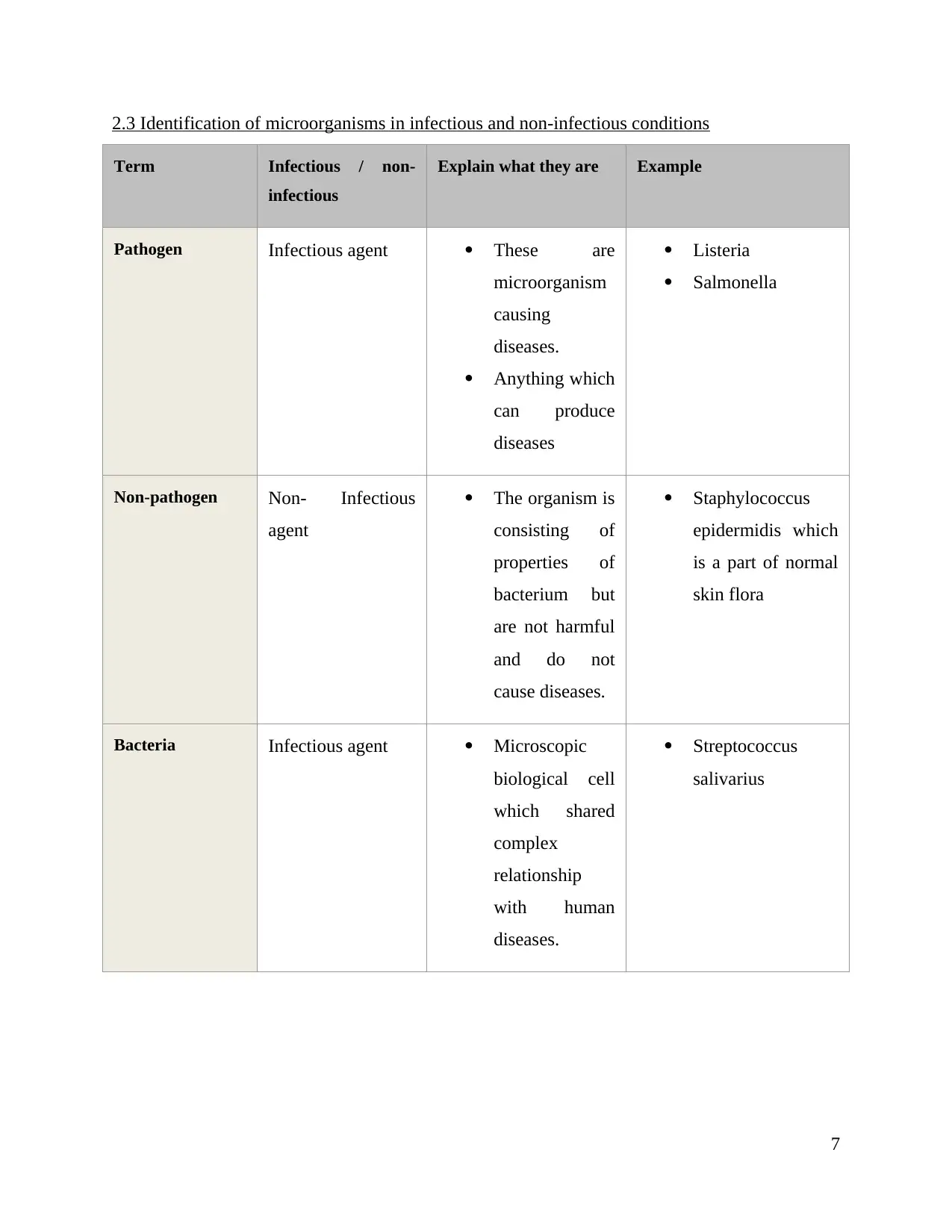
2.3 Identification of microorganisms in infectious and non-infectious conditions
Term Infectious / non-
infectious
Explain what they are Example
Pathogen Infectious agent These are
microorganism
causing
diseases.
Anything which
can produce
diseases
Listeria
Salmonella
Non-pathogen Non- Infectious
agent
The organism is
consisting of
properties of
bacterium but
are not harmful
and do not
cause diseases.
Staphylococcus
epidermidis which
is a part of normal
skin flora
Bacteria Infectious agent Microscopic
biological cell
which shared
complex
relationship
with human
diseases.
Streptococcus
salivarius
7
Term Infectious / non-
infectious
Explain what they are Example
Pathogen Infectious agent These are
microorganism
causing
diseases.
Anything which
can produce
diseases
Listeria
Salmonella
Non-pathogen Non- Infectious
agent
The organism is
consisting of
properties of
bacterium but
are not harmful
and do not
cause diseases.
Staphylococcus
epidermidis which
is a part of normal
skin flora
Bacteria Infectious agent Microscopic
biological cell
which shared
complex
relationship
with human
diseases.
Streptococcus
salivarius
7
Paraphrase This Document
Need a fresh take? Get an instant paraphrase of this document with our AI Paraphraser

Virus Infectious agent These are
biological agent
which
reproduces cells
in living host.
Infected virus
produces
thousands of
identical cells at
an
extraordinary
rate which
causes harmful
diseases and
death.
Hepatitis Virus
8
biological agent
which
reproduces cells
in living host.
Infected virus
produces
thousands of
identical cells at
an
extraordinary
rate which
causes harmful
diseases and
death.
Hepatitis Virus
8
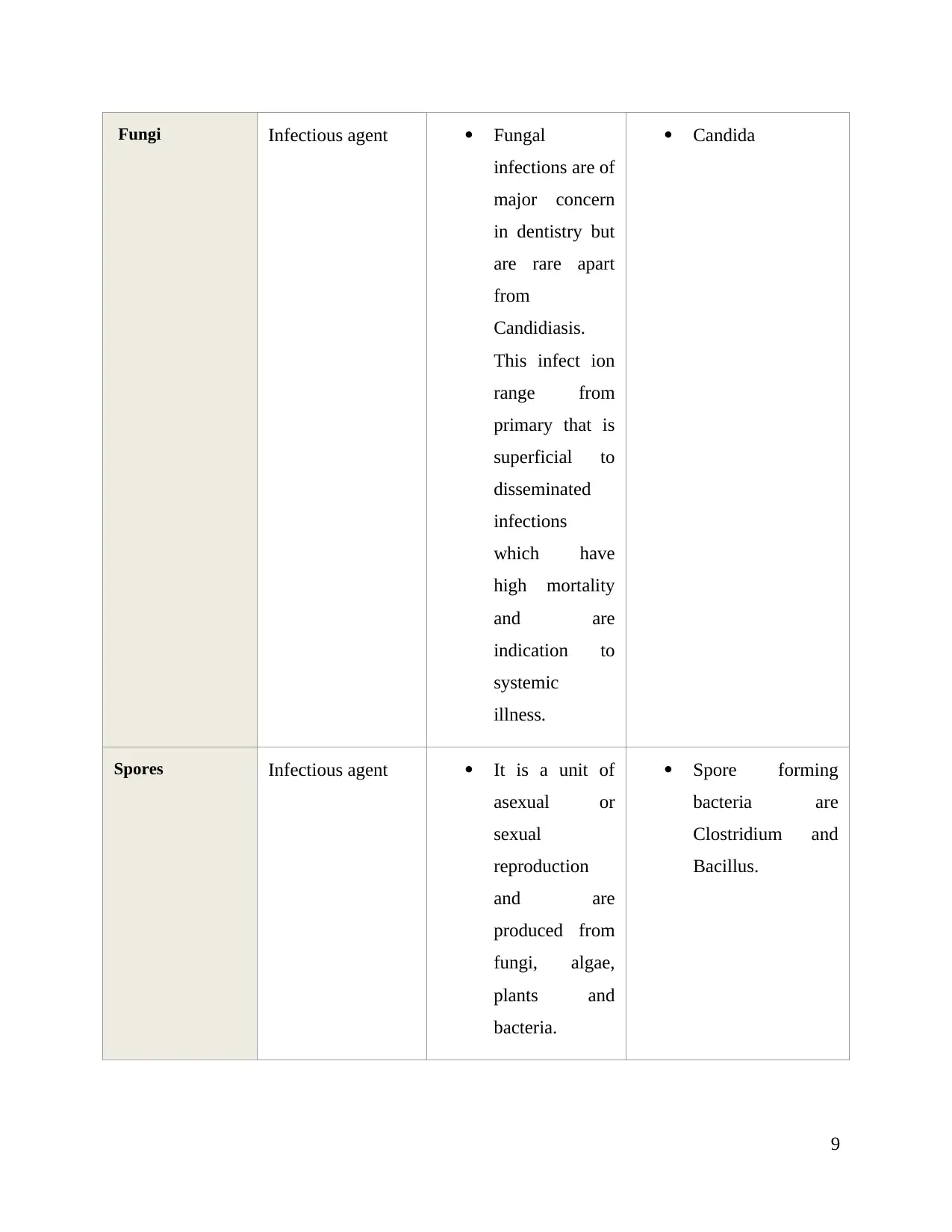
Fungi Infectious agent Fungal
infections are of
major concern
in dentistry but
are rare apart
from
Candidiasis.
This infect ion
range from
primary that is
superficial to
disseminated
infections
which have
high mortality
and are
indication to
systemic
illness.
Candida
Spores Infectious agent It is a unit of
asexual or
sexual
reproduction
and are
produced from
fungi, algae,
plants and
bacteria.
Spore forming
bacteria are
Clostridium and
Bacillus.
9
infections are of
major concern
in dentistry but
are rare apart
from
Candidiasis.
This infect ion
range from
primary that is
superficial to
disseminated
infections
which have
high mortality
and are
indication to
systemic
illness.
Candida
Spores Infectious agent It is a unit of
asexual or
sexual
reproduction
and are
produced from
fungi, algae,
plants and
bacteria.
Spore forming
bacteria are
Clostridium and
Bacillus.
9
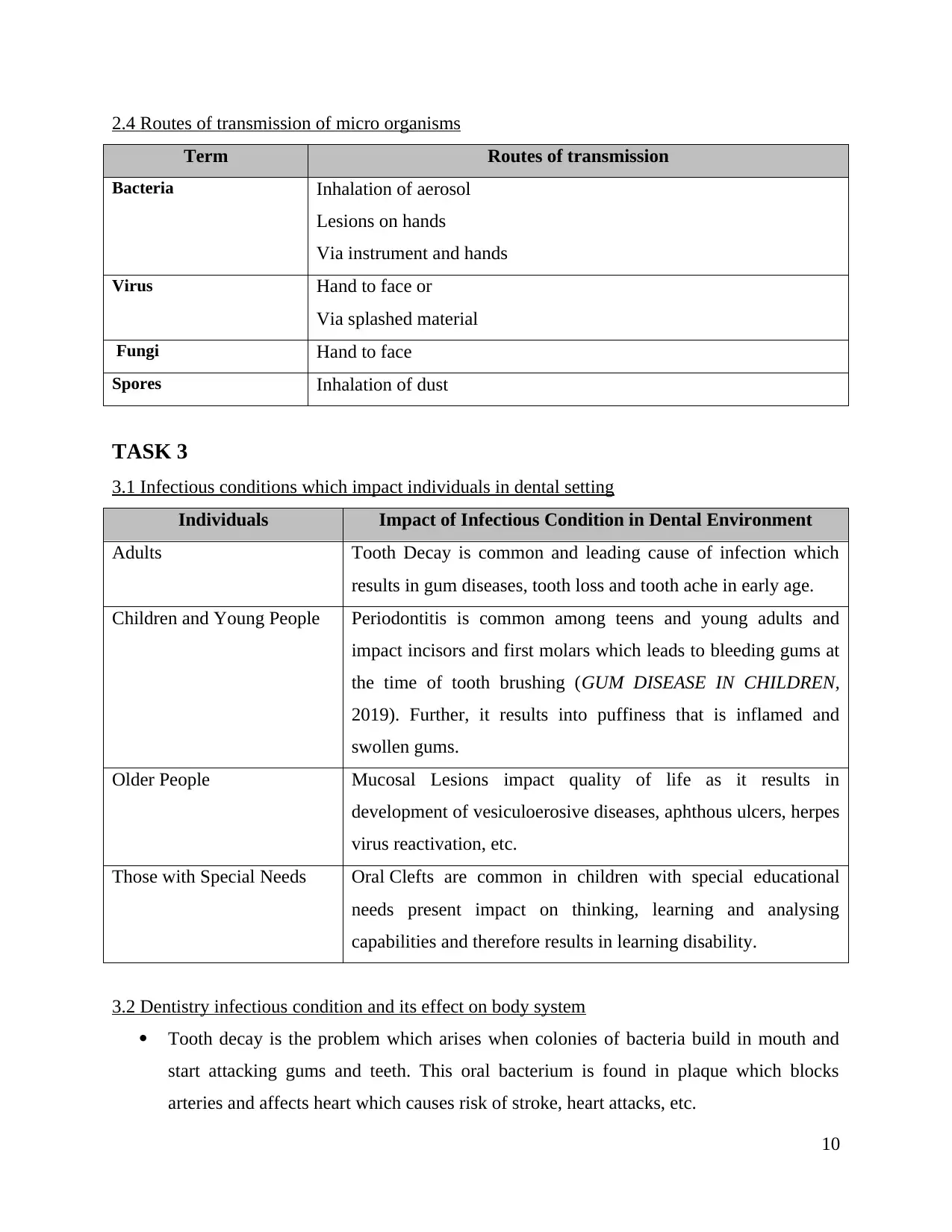
2.4 Routes of transmission of micro organisms
Term Routes of transmission
Bacteria Inhalation of aerosol
Lesions on hands
Via instrument and hands
Virus Hand to face or
Via splashed material
Fungi Hand to face
Spores Inhalation of dust
TASK 3
3.1 Infectious conditions which impact individuals in dental setting
Individuals Impact of Infectious Condition in Dental Environment
Adults Tooth Decay is common and leading cause of infection which
results in gum diseases, tooth loss and tooth ache in early age.
Children and Young People Periodontitis is common among teens and young adults and
impact incisors and first molars which leads to bleeding gums at
the time of tooth brushing (GUM DISEASE IN CHILDREN,
2019). Further, it results into puffiness that is inflamed and
swollen gums.
Older People Mucosal Lesions impact quality of life as it results in
development of vesiculoerosive diseases, aphthous ulcers, herpes
virus reactivation, etc.
Those with Special Needs Oral Clefts are common in children with special educational
needs present impact on thinking, learning and analysing
capabilities and therefore results in learning disability.
3.2 Dentistry infectious condition and its effect on body system
Tooth decay is the problem which arises when colonies of bacteria build in mouth and
start attacking gums and teeth. This oral bacterium is found in plaque which blocks
arteries and affects heart which causes risk of stroke, heart attacks, etc.
10
Term Routes of transmission
Bacteria Inhalation of aerosol
Lesions on hands
Via instrument and hands
Virus Hand to face or
Via splashed material
Fungi Hand to face
Spores Inhalation of dust
TASK 3
3.1 Infectious conditions which impact individuals in dental setting
Individuals Impact of Infectious Condition in Dental Environment
Adults Tooth Decay is common and leading cause of infection which
results in gum diseases, tooth loss and tooth ache in early age.
Children and Young People Periodontitis is common among teens and young adults and
impact incisors and first molars which leads to bleeding gums at
the time of tooth brushing (GUM DISEASE IN CHILDREN,
2019). Further, it results into puffiness that is inflamed and
swollen gums.
Older People Mucosal Lesions impact quality of life as it results in
development of vesiculoerosive diseases, aphthous ulcers, herpes
virus reactivation, etc.
Those with Special Needs Oral Clefts are common in children with special educational
needs present impact on thinking, learning and analysing
capabilities and therefore results in learning disability.
3.2 Dentistry infectious condition and its effect on body system
Tooth decay is the problem which arises when colonies of bacteria build in mouth and
start attacking gums and teeth. This oral bacterium is found in plaque which blocks
arteries and affects heart which causes risk of stroke, heart attacks, etc.
10
Secure Best Marks with AI Grader
Need help grading? Try our AI Grader for instant feedback on your assignments.

Inflamed gums weaken immune system and the disease is known as periodontitis which
impact functioning of rest of the body. According to Makade, Shenoi and Gunwal
(2014), bacteria of periodontitis enters into bloodstream via gum tissue which affect
lungs, heart and other body parts.
3.3 Actions to prevent the spread of infectious diseases
Maintaining hand hygiene
Get immunised
Proper use of antibiotics
Appropriate sterilization procedure
Follow social cleaning plan
Use of single use items
Appropriate waste management procedures
3.4 Summary of immunisation schedule for dental team before exposure to clinical work
Hepatitis B
Bacillus Calmette–Guérin (BCG)
Varicella (chickenpox)
Meningococcal (Meningitis) ...
Mumps (Epidemic Parotitis)
Tetanus
3.5 Reasons for immunisation for dental personnel
Immunisation of dental personnel is essential as the individuals in exposed hazardous
environment which presents biological risk and can result into serious risk like cross
infection.
Immunisation of dental workers is important to maintain compliance with standards of
occupation health and safety which reflects of safety of care providers against contact
with oral fluids and other secretions of service user during treatment (Staff Immunisation
Policy, 2018).
Immunisation is essential because nurses in dentistry are at high risk of influenza,
Rubella, Measles, Hepatitis, etc.
11
impact functioning of rest of the body. According to Makade, Shenoi and Gunwal
(2014), bacteria of periodontitis enters into bloodstream via gum tissue which affect
lungs, heart and other body parts.
3.3 Actions to prevent the spread of infectious diseases
Maintaining hand hygiene
Get immunised
Proper use of antibiotics
Appropriate sterilization procedure
Follow social cleaning plan
Use of single use items
Appropriate waste management procedures
3.4 Summary of immunisation schedule for dental team before exposure to clinical work
Hepatitis B
Bacillus Calmette–Guérin (BCG)
Varicella (chickenpox)
Meningococcal (Meningitis) ...
Mumps (Epidemic Parotitis)
Tetanus
3.5 Reasons for immunisation for dental personnel
Immunisation of dental personnel is essential as the individuals in exposed hazardous
environment which presents biological risk and can result into serious risk like cross
infection.
Immunisation of dental workers is important to maintain compliance with standards of
occupation health and safety which reflects of safety of care providers against contact
with oral fluids and other secretions of service user during treatment (Staff Immunisation
Policy, 2018).
Immunisation is essential because nurses in dentistry are at high risk of influenza,
Rubella, Measles, Hepatitis, etc.
11
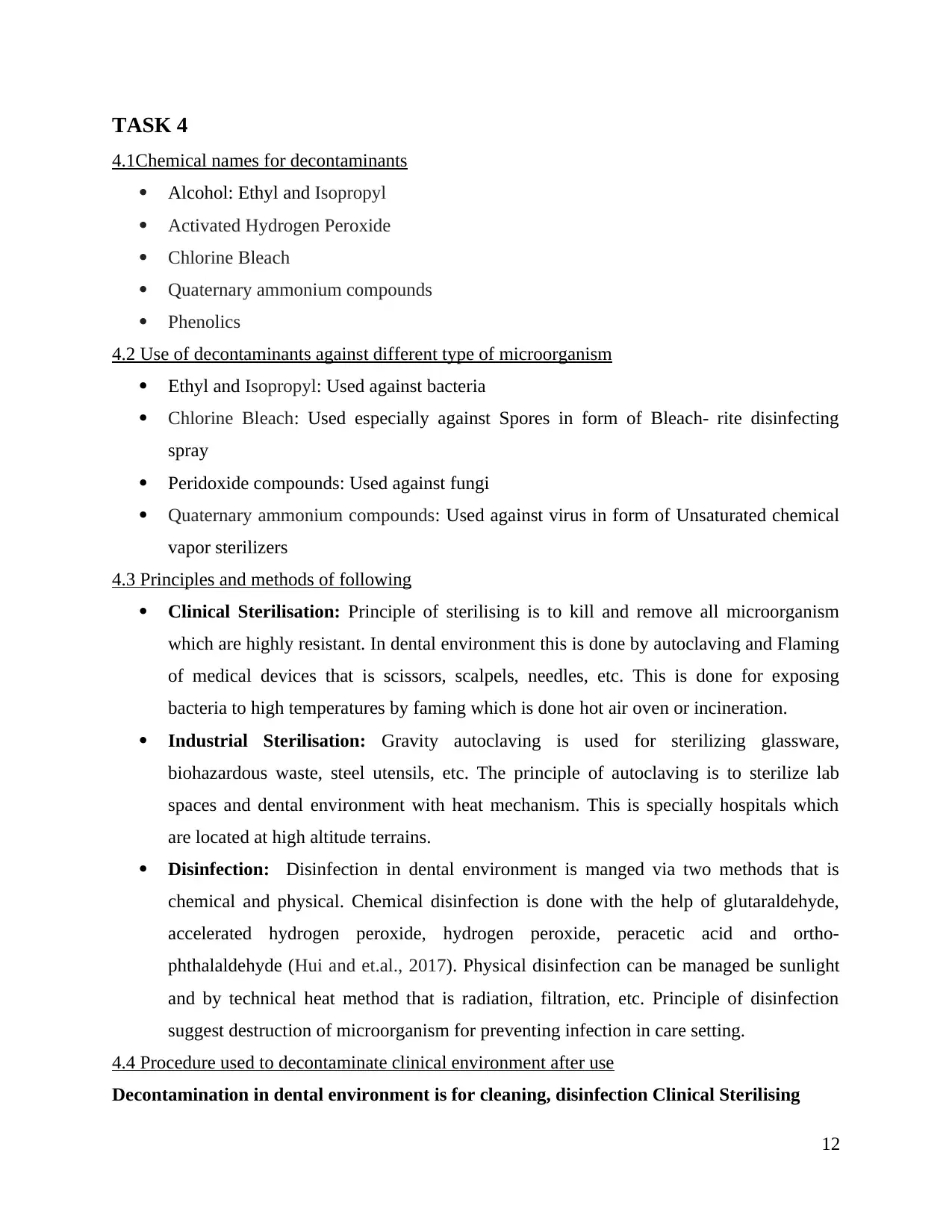
TASK 4
4.1Chemical names for decontaminants
Alcohol: Ethyl and Isopropyl
Activated Hydrogen Peroxide
Chlorine Bleach
Quaternary ammonium compounds
Phenolics
4.2 Use of decontaminants against different type of microorganism
Ethyl and Isopropyl: Used against bacteria
Chlorine Bleach: Used especially against Spores in form of Bleach- rite disinfecting
spray
Peridoxide compounds: Used against fungi
Quaternary ammonium compounds: Used against virus in form of Unsaturated chemical
vapor sterilizers
4.3 Principles and methods of following
Clinical Sterilisation: Principle of sterilising is to kill and remove all microorganism
which are highly resistant. In dental environment this is done by autoclaving and Flaming
of medical devices that is scissors, scalpels, needles, etc. This is done for exposing
bacteria to high temperatures by faming which is done hot air oven or incineration.
Industrial Sterilisation: Gravity autoclaving is used for sterilizing glassware,
biohazardous waste, steel utensils, etc. The principle of autoclaving is to sterilize lab
spaces and dental environment with heat mechanism. This is specially hospitals which
are located at high altitude terrains.
Disinfection: Disinfection in dental environment is manged via two methods that is
chemical and physical. Chemical disinfection is done with the help of glutaraldehyde,
accelerated hydrogen peroxide, hydrogen peroxide, peracetic acid and ortho-
phthalaldehyde (Hui and et.al., 2017). Physical disinfection can be managed be sunlight
and by technical heat method that is radiation, filtration, etc. Principle of disinfection
suggest destruction of microorganism for preventing infection in care setting.
4.4 Procedure used to decontaminate clinical environment after use
Decontamination in dental environment is for cleaning, disinfection Clinical Sterilising
12
4.1Chemical names for decontaminants
Alcohol: Ethyl and Isopropyl
Activated Hydrogen Peroxide
Chlorine Bleach
Quaternary ammonium compounds
Phenolics
4.2 Use of decontaminants against different type of microorganism
Ethyl and Isopropyl: Used against bacteria
Chlorine Bleach: Used especially against Spores in form of Bleach- rite disinfecting
spray
Peridoxide compounds: Used against fungi
Quaternary ammonium compounds: Used against virus in form of Unsaturated chemical
vapor sterilizers
4.3 Principles and methods of following
Clinical Sterilisation: Principle of sterilising is to kill and remove all microorganism
which are highly resistant. In dental environment this is done by autoclaving and Flaming
of medical devices that is scissors, scalpels, needles, etc. This is done for exposing
bacteria to high temperatures by faming which is done hot air oven or incineration.
Industrial Sterilisation: Gravity autoclaving is used for sterilizing glassware,
biohazardous waste, steel utensils, etc. The principle of autoclaving is to sterilize lab
spaces and dental environment with heat mechanism. This is specially hospitals which
are located at high altitude terrains.
Disinfection: Disinfection in dental environment is manged via two methods that is
chemical and physical. Chemical disinfection is done with the help of glutaraldehyde,
accelerated hydrogen peroxide, hydrogen peroxide, peracetic acid and ortho-
phthalaldehyde (Hui and et.al., 2017). Physical disinfection can be managed be sunlight
and by technical heat method that is radiation, filtration, etc. Principle of disinfection
suggest destruction of microorganism for preventing infection in care setting.
4.4 Procedure used to decontaminate clinical environment after use
Decontamination in dental environment is for cleaning, disinfection Clinical Sterilising
12
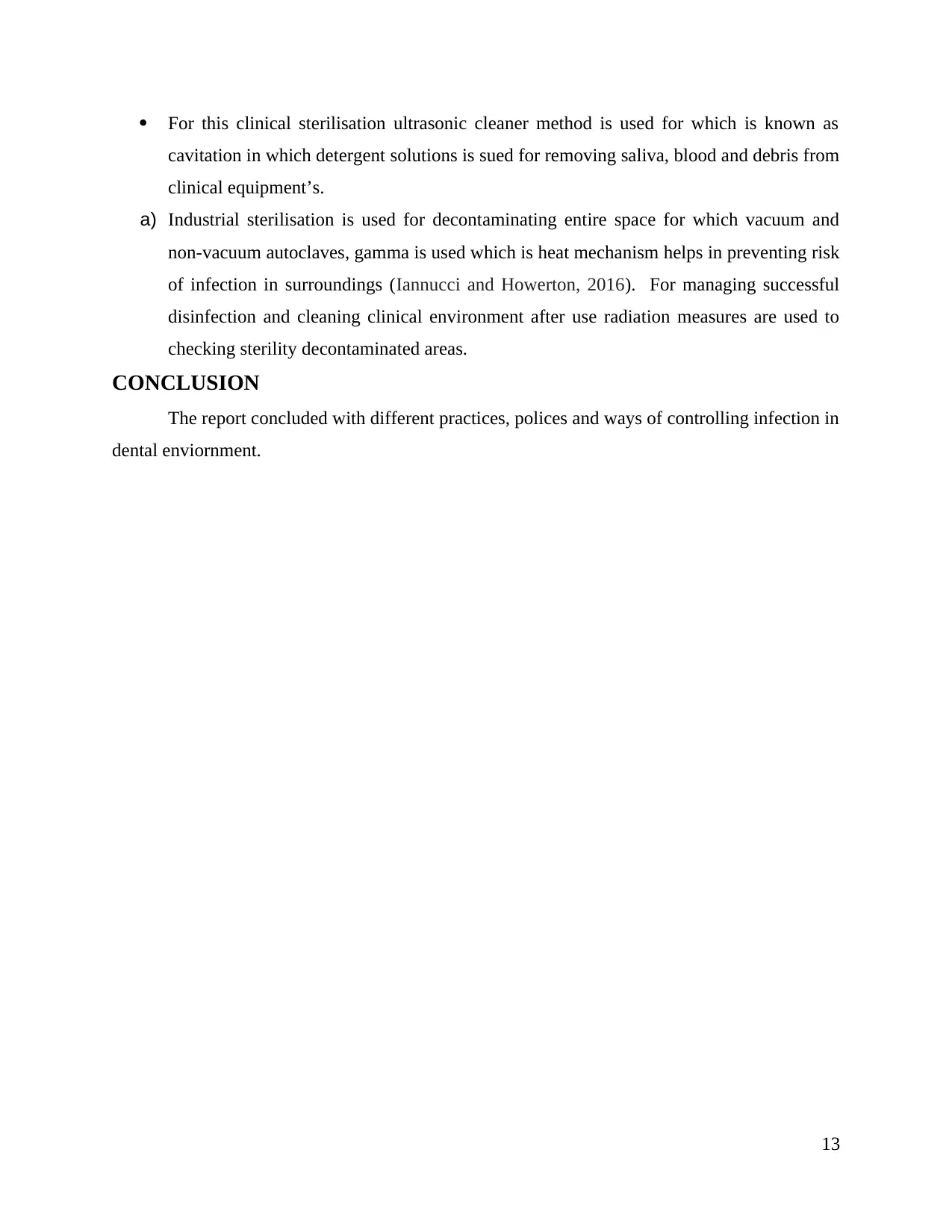
For this clinical sterilisation ultrasonic cleaner method is used for which is known as
cavitation in which detergent solutions is sued for removing saliva, blood and debris from
clinical equipment’s.
a) Industrial sterilisation is used for decontaminating entire space for which vacuum and
non-vacuum autoclaves, gamma is used which is heat mechanism helps in preventing risk
of infection in surroundings (Iannucci and Howerton, 2016). For managing successful
disinfection and cleaning clinical environment after use radiation measures are used to
checking sterility decontaminated areas.
CONCLUSION
The report concluded with different practices, polices and ways of controlling infection in
dental enviornment.
13
cavitation in which detergent solutions is sued for removing saliva, blood and debris from
clinical equipment’s.
a) Industrial sterilisation is used for decontaminating entire space for which vacuum and
non-vacuum autoclaves, gamma is used which is heat mechanism helps in preventing risk
of infection in surroundings (Iannucci and Howerton, 2016). For managing successful
disinfection and cleaning clinical environment after use radiation measures are used to
checking sterility decontaminated areas.
CONCLUSION
The report concluded with different practices, polices and ways of controlling infection in
dental enviornment.
13
Paraphrase This Document
Need a fresh take? Get an instant paraphrase of this document with our AI Paraphraser
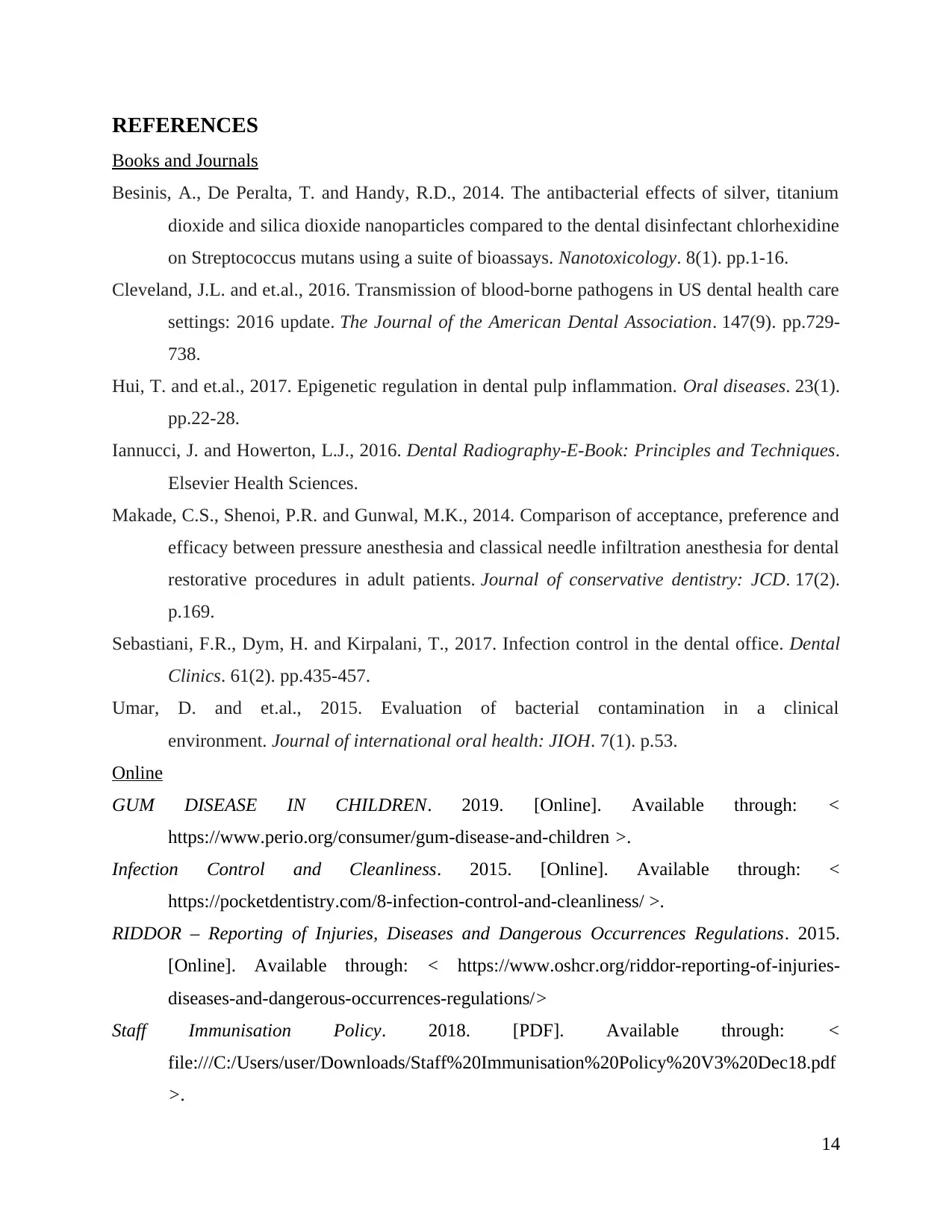
REFERENCES
Books and Journals
Besinis, A., De Peralta, T. and Handy, R.D., 2014. The antibacterial effects of silver, titanium
dioxide and silica dioxide nanoparticles compared to the dental disinfectant chlorhexidine
on Streptococcus mutans using a suite of bioassays. Nanotoxicology. 8(1). pp.1-16.
Cleveland, J.L. and et.al., 2016. Transmission of blood-borne pathogens in US dental health care
settings: 2016 update. The Journal of the American Dental Association. 147(9). pp.729-
738.
Hui, T. and et.al., 2017. Epigenetic regulation in dental pulp inflammation. Oral diseases. 23(1).
pp.22-28.
Iannucci, J. and Howerton, L.J., 2016. Dental Radiography-E-Book: Principles and Techniques.
Elsevier Health Sciences.
Makade, C.S., Shenoi, P.R. and Gunwal, M.K., 2014. Comparison of acceptance, preference and
efficacy between pressure anesthesia and classical needle infiltration anesthesia for dental
restorative procedures in adult patients. Journal of conservative dentistry: JCD. 17(2).
p.169.
Sebastiani, F.R., Dym, H. and Kirpalani, T., 2017. Infection control in the dental office. Dental
Clinics. 61(2). pp.435-457.
Umar, D. and et.al., 2015. Evaluation of bacterial contamination in a clinical
environment. Journal of international oral health: JIOH. 7(1). p.53.
Online
GUM DISEASE IN CHILDREN. 2019. [Online]. Available through: <
https://www.perio.org/consumer/gum-disease-and-children >.
Infection Control and Cleanliness. 2015. [Online]. Available through: <
https://pocketdentistry.com/8-infection-control-and-cleanliness/ >.
RIDDOR – Reporting of Injuries, Diseases and Dangerous Occurrences Regulations. 2015.
[Online]. Available through: < https://www.oshcr.org/riddor-reporting-of-injuries-
diseases-and-dangerous-occurrences-regulations/>
Staff Immunisation Policy. 2018. [PDF]. Available through: <
file:///C:/Users/user/Downloads/Staff%20Immunisation%20Policy%20V3%20Dec18.pdf
>.
14
Books and Journals
Besinis, A., De Peralta, T. and Handy, R.D., 2014. The antibacterial effects of silver, titanium
dioxide and silica dioxide nanoparticles compared to the dental disinfectant chlorhexidine
on Streptococcus mutans using a suite of bioassays. Nanotoxicology. 8(1). pp.1-16.
Cleveland, J.L. and et.al., 2016. Transmission of blood-borne pathogens in US dental health care
settings: 2016 update. The Journal of the American Dental Association. 147(9). pp.729-
738.
Hui, T. and et.al., 2017. Epigenetic regulation in dental pulp inflammation. Oral diseases. 23(1).
pp.22-28.
Iannucci, J. and Howerton, L.J., 2016. Dental Radiography-E-Book: Principles and Techniques.
Elsevier Health Sciences.
Makade, C.S., Shenoi, P.R. and Gunwal, M.K., 2014. Comparison of acceptance, preference and
efficacy between pressure anesthesia and classical needle infiltration anesthesia for dental
restorative procedures in adult patients. Journal of conservative dentistry: JCD. 17(2).
p.169.
Sebastiani, F.R., Dym, H. and Kirpalani, T., 2017. Infection control in the dental office. Dental
Clinics. 61(2). pp.435-457.
Umar, D. and et.al., 2015. Evaluation of bacterial contamination in a clinical
environment. Journal of international oral health: JIOH. 7(1). p.53.
Online
GUM DISEASE IN CHILDREN. 2019. [Online]. Available through: <
https://www.perio.org/consumer/gum-disease-and-children >.
Infection Control and Cleanliness. 2015. [Online]. Available through: <
https://pocketdentistry.com/8-infection-control-and-cleanliness/ >.
RIDDOR – Reporting of Injuries, Diseases and Dangerous Occurrences Regulations. 2015.
[Online]. Available through: < https://www.oshcr.org/riddor-reporting-of-injuries-
diseases-and-dangerous-occurrences-regulations/>
Staff Immunisation Policy. 2018. [PDF]. Available through: <
file:///C:/Users/user/Downloads/Staff%20Immunisation%20Policy%20V3%20Dec18.pdf
>.
14

15

16
Secure Best Marks with AI Grader
Need help grading? Try our AI Grader for instant feedback on your assignments.

17
1 out of 17
Related Documents
Your All-in-One AI-Powered Toolkit for Academic Success.
+13062052269
info@desklib.com
Available 24*7 on WhatsApp / Email
![[object Object]](/_next/static/media/star-bottom.7253800d.svg)
Unlock your academic potential
© 2024 | Zucol Services PVT LTD | All rights reserved.





